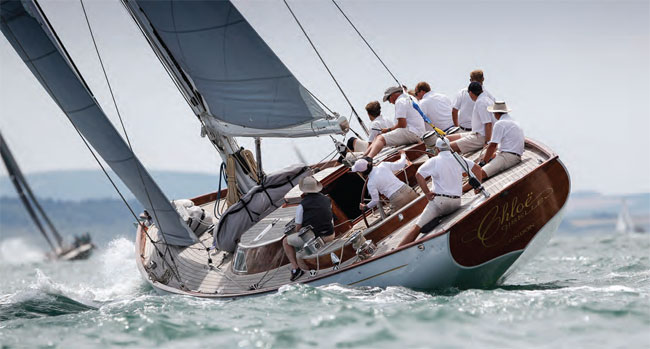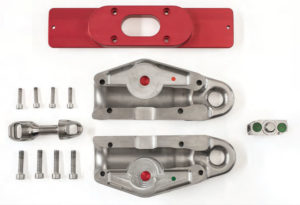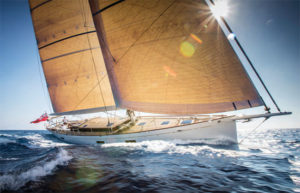Nature’s genius

Timber is still perhaps the ultimate composite material… when used with the best of modern technology
Think of a colour that best represents advanced yacht construction and it is hard not to see black. But while carbon composite technology has dominated the sharp end of the sport for many years, when it comes to the range of resins that have been a part of that development, there’s little that West System epoxy hasn’t seen or been involved with in this field.
But it hasn’t just been carbon that has allowed builders to push at the boundaries, some have been combining the latest composites with the oldest of building materials, wood.
As one of the UK’s longest running users of West System epoxy, Spirit Yachts is a perfect example. Famous for producing their distinctive range of elegant yachts, one of the key elements in their appeal and success has been the way in which they have blended a traditional style and approach to building with modern techniques and materials.
‘Every one of the 74 yachts they have built has used West System epoxy,’ explains Wessex Resins & Adhesives’ sales director Dave Johnson. ‘And during that time the design and engineering has not just evolved, but Spirit Yachts has been adapting and embracing new materials and techniques.
Spirit Yachts is founded on a winning combination of traditional and modern boatbuilding technologies. Strip-planked hulls are formed and bonded on lightweight laminated frames, then clad with multiple opposing veneers and sheathed in glassfibre to produce a light but robust and long-lasting monocoque structure. The whole process from start to finish relies on West System epoxy. Where carbon fibre components are required, they are built on site with Pro-Set epoxy.
‘Aside from the product we supply, we have a close association with them and provide technical support. We help train new staff in the use of products, support new methods and indeed provide support for anything they want to test and trial. In the US we’ve helped to test panels with the Gougeon Brothers’ Hydromat, which uses water pressure in a Hypalon bag to simulate real life load cases. This has fed back into their design process and helped them to develop their build systems as well as the boats themselves.’
Spirit Yachts’ construction process involves bonding laminated frames and longitudinal strip planks with epoxy, then cladding the planking with multiple opposing veneers before sheathing the hull exterior in glass and epoxy. This produces a very light yet robust and long lasting structure.
‘They’ve grown beyond the original strip plank construction method where you would build the strip plank boat and then sheath it,’ says Johnson. ‘Instead, they have treated the strip plank and veneers as a monocoque wood structure, bonded, laminated and sheathed with epoxy. With lightweight laminated transverse frames and floors the hull is really optimised for weight, lifespan and swiftness of build.
‘They use West System 105 epoxy resin, a fast 205 hardener and some slower 206 hardener, depending on what they’re doing. They also add a selection of fillers to create a glue for bonding components or filleting or creating hardware bonding bulkheads to metal fixings. In this case they drill an oversize hole, backfill with epoxy and put a threaded fixing through it. They also use the same epoxy to do the laminating of the sheathing as well. So the system and glass fibre processes are very versatile, one product does many things.’
But as Johnson goes on to explain, there are areas of their work that require a subtly different approach: ‘Spirit Yachts are really embracing modern fibres in conjunction with their builds. It’s a great example of how they are optimising weight without compromising strength or durability ’.
‘For any of the carbon work they use Pro-Set products which have a lower viscosity and longer working times. And that’s totally appropriate for when you’re working with multiple layers of fibre that need to be wetted out fairly readily, or when you’re building something complex that takes a bit of time and may require vacuum consolidation.
‘Some of the parts are infused as well so they use a combination of both Pro-Set LAM and Pro-Set INF infusion epoxy. You can use West System epoxy with carbon, but the viscosity isn’t ideal and the working time is a little bit short. That’s where Pro-Set epoxy comes in. It’s got the right viscosity for either hand laminating or infusion and a slower hardening system for a nice, relaxed working session.’ The alternatives to carbon of course are more difficult to fabricate on site and much heavier, such as stainless steel.
Sometimes mixing the old with the new is not simply about strength. ‘I’ve made countless strip-plank rudders for boats at my yacht club,’ Johnson continues. ‘I’ve made some with a carbon fibre tiller and the combination of lightweight carbon and traditional clear-coated timber works in a way that other mixed materials just don’t.
‘Spirit Yachts has built some beautiful boats that have examples of this balance between wood, epoxy and carbon fabrics and they have looked stunning.’ Evidence perhaps that while the colour that shouts hitech might be black, to those of us with a more refined palate the real answer is more complex.
Click here for more information on Wessex Resins »

This article was originally published in Seahorse Magazine and is kindly reproduced with their permission. To check their archive of free-to-view articles, please visit https://seahorsemagazine.com/archive/2020-archives.
To subscribe to Seahorse at a discounted rate, please click here: http://bit.ly/SHMIN20











